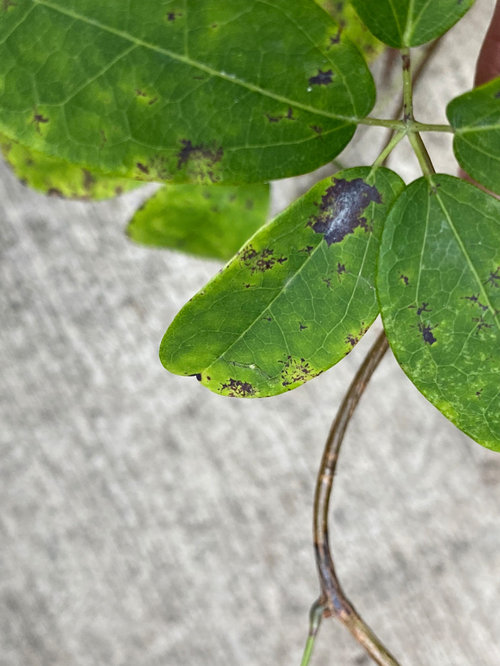I have 3 Akebia Quinata planted along a south-facing fence which gets some morning sun but is otherwise open shade--one is Shirobana (white flowered) and two are purple.
The Shirobana has grown much faster/larger leaved/abundant/verdant.
The 2 standard Quinata have from basically the beginning had these brown spots on their leaves. And toward the end of the growing season (i.e. now) it looks like powdery mildew begins to develop. I've been struggling to understand what the brown spots are--they aren't circular and look like one solid color, but are like someone scribbled them in. They remain like that for months, increasing in quantity and perhaps size only slowly. I do not know if they are related to what I assume is the powdery mildew (see pictures below). I assumed the brown was stress (over- or under-water) but now I'm wondering if it is just how powdery mildew presents early season.
I've tried looking at various nurseries and they basically all have these brown blotches with. Many even have powdery mildew already showing. I tried my luck last fall by buying two that looked good at a local Very Popular Big Nursery--some at the nursery had some of the brown blotches but not all--but lo and behold this Spring the ones I purchased looked like all the others.
That seems odd because all the pictures online they look extremely green.
My questions: is this avoidable/does all Akebia get this in the northwest? Or can this be eradicated if I remove the Akebia, remove all foliage, wait a year to ensure it isn't overwintering, and try again? That is quite a lot of work for something that might just be brought in with the next nursery purchase. But it does affect the lush look of the plant and is very unfortunate.
Note that the Shirobana showed only possibly very few symptoms of this last fall. Right now it only shows some light yellow splotches, possibly some powdery mildew too but very hard to tell at this stage and if so it's minimal. Since they are all right next to each other I guess I can assume that is has definitely spread though.
Thanks!









ken_adrian Adrian MI cold Z5
Related Discussions
Favorite organic gardening recipes
Q
how invasive is bee balm?
Q
Rose help please
Q
February 2018, Week 3, Planting and....Rain, Sleet, Snow
Q